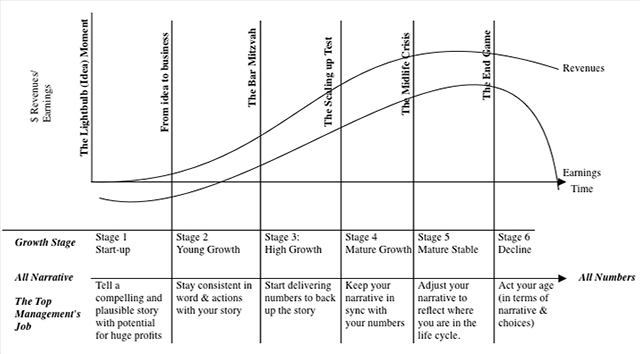In my last two posts, I first looked at Yahoo, in the context of the challenges associated with turning around an aging technology company, and then argued in my second post that the life cycle of tech companies is compressed, relative to non-tech companies. As some of you have noted, there are not only exceptions to this rule, but there are actions, some healthy and some not, that managers of tech companies can, and often do, take to fight aging.
The Tech Life Cycle: The Manager's Handbook
The hyper speed at which their firms move through the life cycle can upend conventional rules on how to manage and finance businesses and there are three strategies that managers at these firms can adopt to survive and each has both a good and a dark side to it.
1. Acceptance/ Denial
In the healthy version of this strategy, as a tech firm (and its managers), you accept the fact that your life cycle will be short and you manage accordingly.
- During your ascendance, it's all about growth: Since your period of growth will be steep and short, you have to keep your focus on delivering that growth. You also cannot afford distractions, whether they come from fights over control or from having to make debt payments.
All of these suggestions, though, are built around accepting the speeded up tech life cycle as a fact of life and working within its constraints.
In the unhealthy version of this strategy, you do nothing to alter the life cycle dynamics for the firm, but manage the firm, in denial, breaking one or more of the three rules listed above. During your growth phase, you allow yourself to diverted by fights over control or debt financing and lose a portion of your growth potential. As your firm matures, you either continue to act like a growth company, pursuing growth (at any cost), and/or borrow money like a non-tech company. In decline, you try to reverse the process by going after the corporate equivalents of tummy tucks and face lifts, corporate do-overs that do not change the end game but enrich others in the process.
2. Reseed and regrow
If you are the manager or owner of a tech company, it is natural to look for an anti-aging serum, something that will let you extend your life. After all, you do have the exceptions to the short life cycle rule, companies that have managed to not just survive over long periods, but continue to grow. This strategy is built on the premise that it is tech products that have short life cycles, not tech companies, and that if you can keep coming up with new tech products, you can extend your life as a company. Your management strategy, if you go with this option, will be to advance the company along two tracks. While nurturing your primary product, you will look for opportunities to extend what you see as your strengths (technology, design, user base), by offering new products and services. In your dream scenario, your initial success gives you a leg up for future successes, leading you to have an extended life cycle as a company.
Promising though this option may look, there are two caveats and they are what characterise the darker version of the strategy. The first is that whether the strategy pays off for your stockholders will depend in large part on what you pay to extend your product portfolio. If the price you pay to add new products and extend your life cycle is greater than the benefits of doing so, you will have a long life cycle, but you will lose value along the way. The second is that the new products that you offer have to scale up, as you become larger. Put differently, a new product that adds fifty million dollars in value is a giant step forward, when you are a hundred million dollar company, but makes only a small difference if you are a billion dollar company. An added and related implication is that the more successful your initial product is in delivering profits and value, the more difficult it becomes to find new products that make a substantial growth contribution.
3. Reinvent
The third and perhaps most promising route for high tech firms that want to stretch out growth periods is to change the business model. Having used low cost entry, easy scaling up and customers switching to climb the growth ladder quickly, you have to work at removing those advantages for the firms that follow you. In particular, you have to try to do one or more of the following:
- Increase the cost of entry: To accomplish this, you can look to legal protection (perhaps through patenting) or by creating gate keepers that slow and perhaps stop new entrants. In my view, both Microsoft and Apple have been helped in their life cycle lengthening efforts by controlling the operating systems that are the standards that competitors often have to follow to enter their respective businesses.
In the darker version of this strategy, the roadblocks you create to competition may expose you not only to bad public relations (as a bully or unfair competitor) but to legal jeopardy, as anti-trust regulators target and try to change your practices. Google and Microsoft, two companies that have adopted this strategy with extraordinary success over the last two decades, have faced this backlash, as a consequence of their success.
The "Right" CEO
The corporate life cycle structure comes with a subtext on what type of management skills are needed at each stage.

Put briefly, the "right" CEO for a company in the growth phase will need vision, charisma and story-telling skills to attract employees, investors and customers to the company. As growth levels off, you need a different set of skills in your CEO, more discipline in seeking out growth and recognizing its limits. In decline, you want a CEO with limited ambitions, who is swilling to shrink the company and sell its assets, at the right price. While this is true for all companies, the process is easier for non-tech companies with long life cycles, where each phase lasts long enough to allow the process to happen naturally (where the CEO ages with the company and hands the reins over to a new one).
The Rest of the Story
- With tech companies, with speeded up life cycles, where a company can go from rising star to declining company in a period of a few years, there is a much greater risk that the start-up CEO (often a founder) will still be at the helm when the company enters its mature and perhaps even declining phases. The qualities that made the CEO a good fit in the startup and growth phases will become a liability as the company matures and declines. There are three implications:
Which is reason to worry about voting rights: In the last decade, technology companies have moved away from the "one share, one vote" paradigm that governed US companies for decades. That trend, started by Google, but extended by the social media companies, has been ignored as these companies grow rapidly but will become an issue for investors, when growth slows at these companies and the founders/insiders go into denial model. If you are a stockholder in one of these young tech companies with unequal voting rights, you will regret your inability to have a say in how these companies are run, sooner rather than later.
Also Read:
This article first appeared in Aswath Damodaran’s blog.
(Aswath Damodaran is a professor of finance at the Stern School of Business at NYU.)







